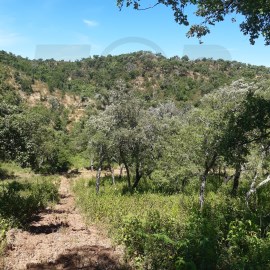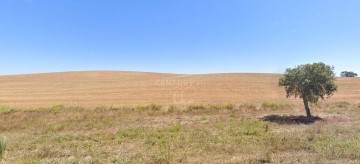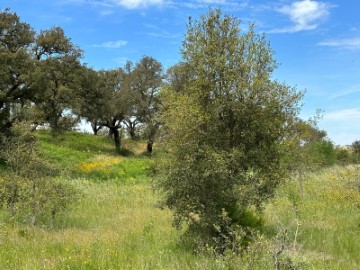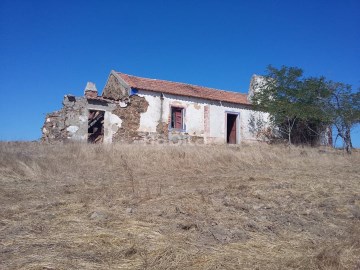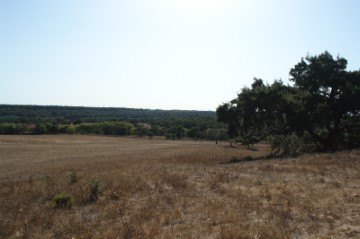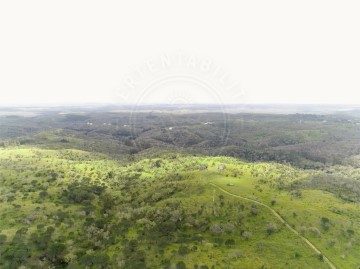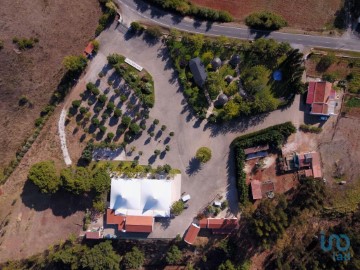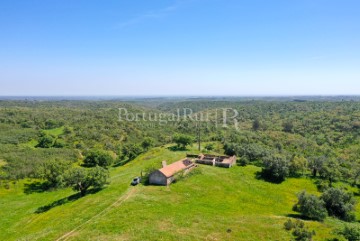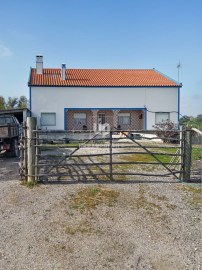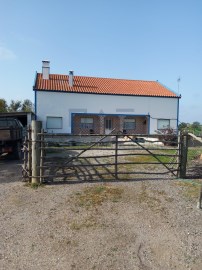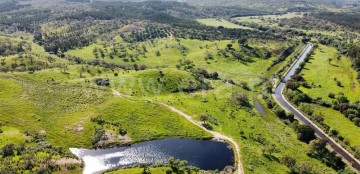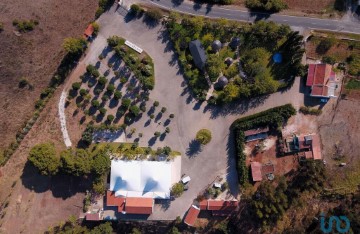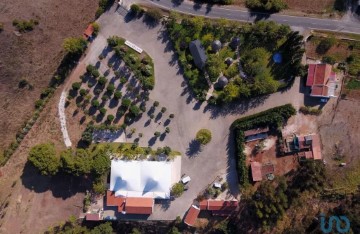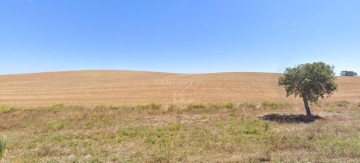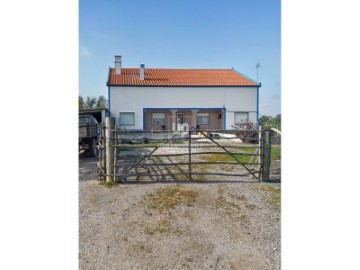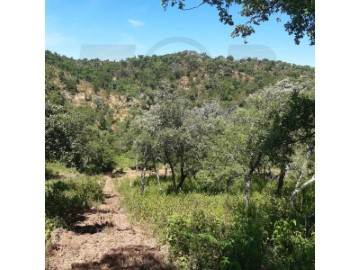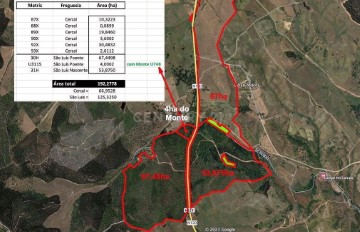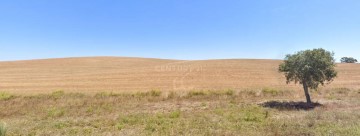Country homes in São Francisco da Serra
São Francisco da Serra, Santiago do Cacém, Setúbal
2.770.000€.
Herdade junto à Aldeia do Roncão, composta por uma área de terreno de 85 hectares, um monte para recuperar com a possibilidade de ampliação. Tem ainda uma área em ruína, para apoio agrícola, com a possibilidade de ampliação com áreas bastantes consideráveis..
Montado de sobro em quase toda a propriedade, linhas de água e poço.
Uma paisagem em que predomina a imensidão de campo, com vista sobre a Aldeia, e onde o silêncio é absoluto, a pouco mais de 20 minutos das praias do Litoral Alentejano.
Um espaço que pode ser transformado em empreendimento turístico ou para investimento em projetos de energias renováveis.
Excelente oportunidade.
Financiamento Bancário:
A Top imóveis é parceira de várias entidades financeiras possibilitando a todos os seus clientes simulações gratuitas de Crédito à Habitação.
Localização:
Santiago do Cacém é uma cidade portuguesa no Distrito de Setúbal, é sede de um dos maiores municípios de Portugal, com 1 059,77 km² de área.
É sede de um dos maiores municípios de Portugal, com 1 059,77 km² de área e 29 749 habitantes (2015 INE), subdividido em 8 freguesias.
O município é limitado a norte pelo termo de Grândola, a nordeste por Ferreira do Alentejo, a leste por Aljustrel, a sul por Ourique e Odemira e a oeste por Sines e tem litoral no oceano Atlântico. É o único município de todo o Alentejo que contém 2 cidades dentro do seu termo (Santiago e Santo André). Possui ainda três vilas (Cercal, Alvalade e Ermidas-Sado).
História:
O seu nome deriva do Governador Mouro Kassim e da Ordem de Santiago.
Dotada de uma localização geográfica estratégica, as populações humanas procuraram, desde épocas remotas, esta região para se estabelecer. As escavações efetuadas no Castelo Velho, onde se situam as ruínas romanas de Miróbriga, demonstram que a região foi habitada desde a Pré-história.
As ruinas de Miróbriga representam um dos mais marcantes vestígios da ocupação dos Romanos no Sudoeste de Portugal.
Foi classificada de Imóvel de Interesse Público, em 1940. A cidade romana estende-se por mais de 2 km, apresentando ruínas de edifícios de habitação, ruas pavimentadas, um hipódromo, termas, uma ponte e um fórum.
Com a colonização romana, desenvolveu-se para a área comercial em torno do fórum. As termas, entre as mais bem preservadas em Portugal. Relativamente perto das termas, existe uma ponte com um único arco semicircular. O hipódromo é o único completamente conhecido em Portuga e está localizado mais longe do centro.
Terá sido por volta de 712 e já após o declínio de Miróbriga que os mouros atingiram o território, edificando o castelo na colina defronte; pensa-se inclusivamente que o nome Kassem estará ligado ao alcaide mouro. A ocupação moura prolongou-se até ao séc. XII e muitas batalhas pela reconquista se travaram no território até que, em 1217, voltou definitivamente à posse dos cristãos, tendo D. Afonso II confirmado a doação de seu pai à Ordem dos Espatários.
Economia:
No concelho predominam as atividades ligadas ao setor primário, seguidas das do secundário e do terciário.
A agricultura mantém ainda uma grande importância, com 43,9% da área do concelho destinados à exploração agrícola, destacando-se os cultivos de cereais para grão, de prados temporários e de culturas forrageiras, de culturas industriais, do pousio, do olival, de prados e de pastagens permanentes.
A pecuária reveste-se também de alguma importância, nomeadamente na criação de aves, ovinos e suínos.
Cerca de 7785 hectares do seu território são cobertos de floresta.
Assim, a agricultura, a suinicultura e o descasque de arroz são as atividades de maior importância, seguidas pela indústria, nomeadamente as oficinas auto, a construção civil, a serralharia civil, a transformação de mármores, a serração de madeira e a transformação de cortiça.
Cultura e lazer:
São muitas as manifestações populares e culturais no concelho: a festa de Nossa Senhora da Graça, realizada no último domingo de maio, com várias cerimónias religiosas, designadamente encontros de oração, e as feiras anuais, no quarto domingo de abril e no quarto domingo de julho; a Santiagro, 'Feira Agrícola', em maio, de promoção económica e cultural; a FATAL - Feira de Artesanato e Turismo do Alentejo Litoral; as festas tradicionais de Relvas Verdes, ambas em julho; a Feira do Monte, em setembro; as festas tradicionais de Aldeia dos Chãos, em agosto, e o Dia do Município, a 25 de julho.
No artesanato, salientam-se os trabalhos de latoaria, as rendas, os bordados, os trabalhos em barro e de cortiça, a tapeçaria e a madeira.
Como instalação cultural, o concelho possui o Museu Municipal de Santiago do Cacém, no qual são de relevar as secções de numismática e de arqueologia, esta última representativa da ocupação humana na região, desde os tempos do Paleolítico Superior. Na coleção de etnografia, destaque para a cozinha tradicional alentejana, a que se junta a recriação de um quarto popular, o qual faz contraponto com outro de gosto marcadamente burguês e que se insere num notável legado de uma das famílias da região - os Condes de Avillez.
Em 1895 chega a Portugal o primeiro automóvel, propriedade do Conde de Avilez, de Santiago do Cacém;
A titulo de curiosidade, também o 1. Rolls Royce que veio para Portugal, veio para Santiago do Cacém, propriedade de José Sande Champalimaud e o registo automóvel com n. 1,em 1904, foi igualmente para Santiago do Cacém, em nome de Augusto Teixeira de Aragão.
A 1,5h de Lisboa, 30m das praias do Carvalhal e da Comporta, 20m de Melides, esta excelente centralidade ainda está sub-explorada e você pode desenvolve-la com o seu bom gosto
Pontos a visitar:
- Castelo de Santiago do Cacém
- Estação Arqueológica de Miróbriga
- Museu Municipal de Santiago do Cacém
- Castelo de Santiago do Cacém
- Badoca Safari Park
- Ponte medieval de Alvalade
- Área do Castelo Velho com as ruínas da cidade romana Miróbriga
- Igreja de Santiago ou Igreja Matriz de Santiago do Cacém
Se você tem o sonho...nós temos a solução! Venha visitar aquele que pode ser o seu futuro negócio!!
Marque a sua visita
A TOPIMÓVEIS, com escritório em Av. do Século n 126 Samora Correia, Licença AMI 14208, é a entidade responsável pelo anúncio através do qual os Utilizadores, Destinatários do Serviço ou Clientes têm acesso remoto aos serviços e produtos da ' TOPIMÓVEIS', que são apresentados, comercializados ou prestados.
Homestead next to Aldeia do Roncão, consisting of a land area of 85 hectares, a lot to recover with the possibility of expansion. It also has an area in ruins, for agricultural support, with the possibility of expansion with quite considerable areas.
Mounted cork oak on almost the entire property, water lines and well.
A landscape in which the immensity of countryside predominates, with a view over the village, and where silence is absolute, just over 20 minutes from the beaches of the Alentejo coast.
A space that can be transformed into a tourist development or investment in renewable energy projects.
Excellent opportunity.
Bank Financing:
Top real estate is a partner of several financial institutions allowing all its customers free simulations of Housing Credit.
Localization:
Santiago do Cacém is a Portuguese city in the District of Setúbal, it is the seat of one of the largest municipalities in Portugal, with an area of 1,059.77 km².
It is the seat of one of the largest municipalities in Portugal, with an area of 1,059.77 km² and 29,749 inhabitants (2015 INE), subdivided into 8 parishes.
The municipality is limited to the north by the term Grândola, to the northeast by Ferreira do Alentejo, to the east by Aljustrel, to the south by Ourique and Odemira and to the west by Sines and has a coastline on the Atlantic Ocean. It is the only municipality in the entire Alentejo that contains 2 cities within its territory (Santiago and Santo André). It also has three villages (Cercal, Alvalade and Ermidas-Sado).
History:
Its name derives from the Moorish Governor Kassim and the Order of Santiago.
Endowed with a strategic geographic location, human populations have sought, since remote times, this region to settle. The excavations carried out in Castelo Velho, where the Roman ruins of Miróbriga are located, demonstrate that the region has been inhabited since Prehistory.
The ruins of Miróbriga represent one of the most striking vestiges of the Roman occupation in Southwest Portugal.
It was classified as a Property of Public Interest in 1940. The Roman city extends over 2 km, with ruins of residential buildings, paved streets, a hippodrome, baths, a bridge and a forum.
With Roman colonization, it developed into the commercial area around the forum. The spas, among the best preserved in Portugal. Relatively close to the baths, there is a bridge with a single semicircular arch. The hippodrome is the only one completely known in Portugal and is located further from the center.
It would have been around 712 and after the decline of Miróbriga that the Moors reached the territory, building the castle on the hill opposite; it is even thought that the name Kassem is linked to the Moorish mayor. The Moorish occupation lasted until the 17th century. XII and many battles for the reconquest were fought in the territory until, in 1217, it definitively returned to the possession of the Christians, having D. Afonso II confirmed the donation of his father to the Order of the Spatarians.
Economy:
In the municipality, activities related to the primary sector predominate, followed by secondary and tertiary activities.
Agriculture is still of great importance, with 43.9% of the county's area being used for farming, with emphasis on the cultivation of cereals for grain, temporary meadows and forage crops, industrial crops, fallow land, olive groves, of meadows and permanent pastures.
Livestock is also of some importance, namely in poultry, sheep and pigs.
About 7785 hectares of its territory are covered with forest.
Thus, agriculture, pig farming and rice husking are the most important activities, followed by industry, namely auto repair shops, civil construction, civil locksmithing, marble processing, wood sawing and cork processing. .
Culture and leisure:
There are many popular and cultural events in the municipality: the feast of Nossa Senhora da Graça, held on the last Sunday of May, with various religious ceremonies, namely prayer meetings, and the annual fairs, on the fourth Sunday of April and the fourth Sunday of July; Santiagro, 'Agricultural Fair', in May, for economic and cultural promotion; FATAL - Handicraft and Tourism Fair of Alentejo Litoral; the traditional festivals of Relvas Verdes, both in July; the Feira do Monte, in September; the traditional festivals of Aldeia dos Chãos, in August, and the Municipality Day, on the 25th of July.
In handicrafts, the highlights are tin work, lace, embroidery, clay and cork work, tapestry and wood.
As a cultural facility, the municipality has the Municipal Museum of Santiago do Cacém, in which the numismatics and archeology sections are noteworthy, the latter representative of human occupation in the region, since the Upper Paleolithic times. In the ethnography collection, the highlight is the traditional Alentejo cuisine, which is joined by the recreation of a popular room, which contrasts with another with a markedly bourgeois taste and which is based onere in a remarkable legacy of one of the families of the region - the Counts of Avillez.
In 1895, the first car arrived in Portugal, owned by the Conde de Avilez, from Santiago do Cacém;
As a curiosity, also the 1st Rolls Royce that came to Portugal, came to Santiago do Cacém, property of José Sande Champalimaud and car registration number 1, in 1904, also went to Santiago do Cacém, in the name of by Augusto Teixeira de Aragão.
1.5h from Lisbon, 30m from the beaches of Carvalhal and Comporta, 20m from Melides, this excellent centrality is still under-explored and you can develop it with your own taste.
Points to visit:
- Castle of Santiago do Cacem
- Archaeological Station of Miróbriga
- Municipal Museum of Santiago do Cacém
- Castle of Santiago do Cacem
- Badoca Safari Park
- Medieval bridge of Alvalade
- Old Castle area with the ruins of the Roman city Miróbriga
- Church of Santiago or Mother Church of Santiago do Cacém
If you have the dream...we have the solution! Come visit what could be your future business!!
Book your visit
TOPIMÓVEIS, with an office at Av. do Século n 126 Samora Correia, License AMI 14208, is the entity responsible for the advertisement through which Users, Service Recipients or Customers have remote access to 'TOPIMÓVEIS' services and products, which are presented, marketed or provided.
Ferme à côté d'Aldeia do Roncão, composée d'un terrain de 85 hectares, beaucoup à récupérer avec possibilité d'agrandissement. Il dispose également d'une zone en ruine, pour le soutien agricole, avec possibilité d'expansion avec des zones assez considérables.
Monté en chêne liège sur la quasi-totalité de la propriété, conduites d'eau et puits.
Un paysage où prédomine l'immensité de la campagne, avec vue sur le village, et où le silence est absolu, à un peu plus de 20 minutes des plages de la côte de l'Alentejo.
Un espace qui peut être transformé en développement touristique ou en investissement dans des projets d'énergie renouvelable.
Une opportunité excellente.
Financement bancaire :
Top immobilier est partenaire de plusieurs établissements financiers permettant à tous ses clients des simulations gratuites de Crédit Logement.
Localisation:
Santiago do Cacém est une ville portugaise du district de Setúbal, c'est le siège de l'une des plus grandes municipalités du Portugal, avec une superficie de 1 059,77 km².
C'est le siège de l'une des plus grandes municipalités du Portugal, avec une superficie de 1 059,77 km² et 29 749 habitants (INE 2015), subdivisée en 8 paroisses.
La municipalité est limitée au nord par le terme Grândola, au nord-est par Ferreira do Alentejo, à l'est par Aljustrel, au sud par Ourique et Odemira et à l'ouest par Sines et a un littoral sur l'océan Atlantique. C'est la seule municipalité de tout l'Alentejo qui contient 2 villes sur son territoire (Santiago et Santo André). Elle compte également trois villages (Cercal, Alvalade et Ermidas-Sado).
Histoire:
Son nom dérive du gouverneur maure Kassim et de l'Ordre de Santiago.
Dotée d'une situation géographique stratégique, les populations humaines ont cherché, depuis des temps reculés, cette région pour s'installer. Les fouilles effectuées à Castelo Velho, où se trouvent les ruines romaines de Miróbriga, démontrent que la région est habitée depuis la Préhistoire.
Les ruines de Miróbriga représentent l'un des vestiges les plus frappants de l'occupation romaine dans le sud-ouest du Portugal.
Elle a été classée Bien d'Intérêt Public en 1940. La ville romaine s'étend sur 2 km, avec des ruines d'édifices résidentiels, des rues pavées, un hippodrome, des thermes, un pont et un forum.
Avec la colonisation romaine, il s'est développé en zone commerciale autour du forum. Les thermes, parmi les mieux conservés du Portugal. Assez proche des thermes, on trouve un pont à un seul arc en plein cintre. L'hippodrome est le seul complètement connu au Portugal et est situé plus loin du centre.
Ce serait vers 712 et après le déclin de Miróbriga que les Maures atteignirent le territoire, construisant le château sur la colline d'en face ; on pense même que le nom Kassem est lié au maire maure. L'occupation mauresque dura jusqu'au XVIIe siècle. XII et de nombreuses batailles pour la reconquête ont eu lieu sur le territoire jusqu'à ce qu'en 1217, il revienne définitivement aux mains des chrétiens, après que D. Afonso II ait confirmé la donation de son père à l'Ordre des Spatariens.
Économie:
Dans la commune, les activités liées au secteur primaire prédominent, suivies des secteurs secondaire et tertiaire.
L'agriculture est toujours d'une grande importance, avec 43,9% de la superficie du département utilisée pour l'agriculture, en mettant l'accent sur la culture de céréales à grains, de prairies temporaires et de cultures fourragères, de cultures industrielles, de jachères, d'oliviers, de prairies et de pâturages permanents.
L'élevage a également une certaine importance, notamment dans l'élevage de volailles, de moutons et de porcs.
Environ 7785 hectares de son territoire sont couverts de forêt.
Ainsi, l'agriculture, l'élevage porcin et le décorticage du riz sont les activités les plus importantes, suivies par l'industrie, à savoir les ateliers de réparation automobile, la construction civile, la serrurerie civile, la transformation du marbre, le sciage du bois et la transformation du liège. .
Culture et loisirs :
Les manifestations populaires et culturelles de la commune sont nombreuses : la fête de Nossa Senhora da Graça, célébrée le dernier dimanche de mai, avec diverses cérémonies religieuses, notamment les réunions de prière, et les foires annuelles, le quatrième dimanche d'avril et le quatrième dimanche de juillet; Santiagro, 'Foire Agricole', en mai, pour la promotion économique et culturelle; FATAL - Salon de l'artisanat et du tourisme de l'Alentejo Litoral ; les fêtes traditionnelles de Relvas Verdes, toutes deux en juillet ; la Feira do Monte, en septembre ; les fêtes traditionnelles d'Aldeia dos Chãos, en août, et la fête municipale, le 25 juillet.
Dans l'artisanat, les points forts sont le travail de l'étain, la dentelle, la broderie, le travail de l'argile et du liège, la tapisserie et le bois.
En tant qu'équipement culturel, la municipalité possède le Musée municipal de Santiago do Cacém, dans lequel les sections de numismatique et d'archéologie sont remarquables, cette dernière représentant l'occupation humaine dans la région, depuis le Paléolithique supérieur. Dans la collection d'ethnographie, le point culminant est la cuisine traditionnelle de l'Alentejo, qui est rejointe par la recréation d'une salle populaire, qui contraste avec une autre au goût nettement bourgeois et qui est basée sur ici dans un héritage remarquable d'une des familles de la région - les comtes d'Avillez.
En 1895, la première voiture est arrivée au Portugal, propriété du Conde de Avilez, de Santiago do Cacém ;
Par curiosité, également la 1ère Rolls Royce qui est venue au Portugal, est venue à Santiago do Cacém, propriété de José Sande Champalimaud et numéro d'immatriculation 1, en 1904, est également allée à Santiago do Cacém, au nom de par Augusto Teixeira de Aragão .
A 1h30 de Lisbonne, 30m des plages de Carvalhal et Comporta, 20m de Melides, cette excellente centralité est encore sous-explorée et vous pouvez la développer à votre guise.
Points à visiter :
- Château de Santiago do Cacem
- Station archéologique de Miróbriga
- Musée municipal de Santiago do Cacém
- Château de Santiago do Cacem
- Parc safari de Badoca
- Pont médiéval d'Alvalade
- Zone du vieux château avec les ruines de la ville romaine Miróbriga
- Église de Santiago ou Église Mère de Santiago do Cacém
Si vous avez le rêve... nous avons la solution ! Venez visiter ce qui pourrait être votre futur commerce!!
Réservez votre visite
TOPIMÓVEIS, avec un bureau à Av. do Século n 126 Samora Correia, licence AMI 14208, est l'entité responsable de la publicité à travers laquelle les utilisateurs, les destinataires du service ou les clients ont accès à distance aux services et produits 'TOPIMÓVEIS', qui sont présentés, commercialisés ou fourni.
#ref:15683682
2.770.000 €
30+ days ago bpiexpressoimobiliario.pt
View property
